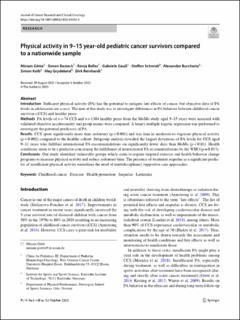| dc.contributor.author | Götte, Miriam | |
| dc.contributor.author | Basteck, Simon | |
| dc.contributor.author | Beller, Ronja | |
| dc.contributor.author | Gauß, Gabriele | |
| dc.contributor.author | Schmidt, Steffen | |
| dc.contributor.author | Burchartz, Alexander | |
| dc.contributor.author | Kolb, Simon | |
| dc.contributor.author | Grydeland, May | |
| dc.contributor.author | Reinhardt, Dirk | |
| dc.date.accessioned | 2022-12-01T12:26:36Z | |
| dc.date.available | 2022-12-01T12:26:36Z | |
| dc.date.created | 2022-10-17T08:24:57Z | |
| dc.date.issued | 2022 | |
| dc.identifier.citation | Journal of Cancer Research and Clinical Oncology. 2022, Artikkel 04392-5. | en_US |
| dc.identifier.issn | 0171-5216 | |
| dc.identifier.uri | https://hdl.handle.net/11250/3035354 | |
| dc.description | This article is licensed under a Creative Commons Attribution 4.0 International License, which permits use, sharing, adaptation, distribution and reproduction in any medium or format, as long as you give appropriate credit to the original author(s) and the source, provide a link to the Creative Commons licence, and indicate if changes were made. The images or other third party material in this article are included in the article's Creative Commons licence, unless indicated otherwise in a credit line to the material. If material is not included in the article's Creative Commons licence and your intended use is not permitted by statutory regulation or exceeds the permitted use, you will need to obtain permission directly from the copyright holder. | en_US |
| dc.description.abstract | Introduction: Sufficient physical activity (PA) has the potential to mitigate late effects of cancer, but objective data of PA levels in adolescents are scarce. The aim of this study was to investigate differences in PA behavior between childhood cancer survivors (CCS) and healthy peers.
Methods: PA levels of n = 74 CCS and n = 1304 healthy peers from the MoMo study aged 9–15 years were assessed with validated objective accelerometry and group means were compared. A binary multiple logistic regression was performed to investigate the potential predictors of PA.
Results: CCS spent significantly more time sedentary (p < 0.001) and less time in moderate-to-vigorous physical activity (p = 0.002) compared to the healthy cohort. Subgroup analysis revealed the largest deviations of PA levels for CCS aged 9–11 years who fulfilled international PA recommendations on significantly fewer days than MoMo (p < 0.01). Health conditions seem to be a predictor concerning the fulfillment of international PA recommendations by the WHO (p = 0.015).
Conclusions: Our study identified vulnerable groups which seem to require targeted exercise and health behavior change programs to increase physical activity and reduce sedentary time. The presence of treatment sequelae as a significant predictor of insufficient physical activity underlines the need of multidisciplinary supportive care approaches. | en_US |
| dc.language.iso | eng | en_US |
| dc.subject | childhood cancer | en_US |
| dc.subject | exercise | en_US |
| dc.subject | health promotion | en_US |
| dc.subject | leukemia | en_US |
| dc.subject | sequelae | en_US |
| dc.title | Physical activity in 9–15 year-old pediatric cancer survivors compared to a nationwide sample | en_US |
| dc.type | Peer reviewed | en_US |
| dc.type | Journal article | en_US |
| dc.description.version | publishedVersion | en_US |
| dc.rights.holder | © The Author(s) 2022 | en_US |
| dc.source.pagenumber | 11 | en_US |
| dc.source.journal | Journal of Cancer Research and Clinical Oncology | en_US |
| dc.identifier.doi | 10.1007/s00432-022-04392-5 | |
| dc.identifier.cristin | 2061809 | |
| dc.description.localcode | Institutt for fysisk prestasjonsevne / Department of Physical Performance | en_US |
| dc.source.articlenumber | 04392-5 | en_US |
| cristin.ispublished | true | |
| cristin.fulltext | original | |
| cristin.qualitycode | 1 | |
